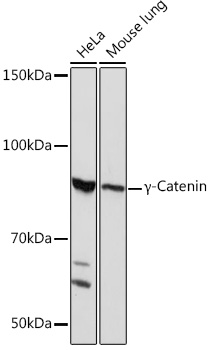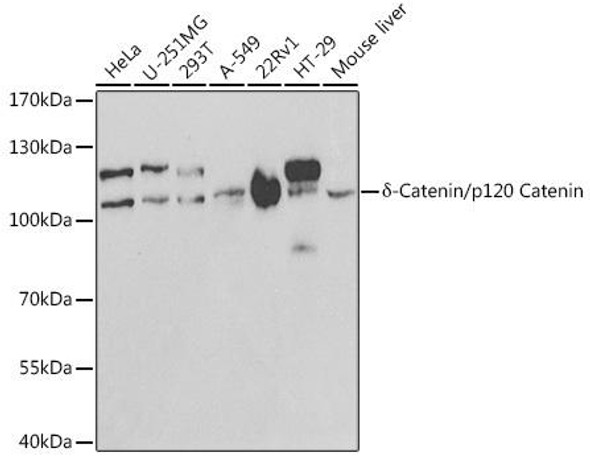Cell Biology Antibodies 17
Anti-Gamma-Catenin Antibody (CAB4157)
- SKU:
- CAB4157
- Product Type:
- Antibody
- Reactivity:
- Human
- Reactivity:
- Mouse
- Reactivity:
- Rat
- Host Species:
- Rabbit
- Isotype:
- IgG
- Research Area:
- Cell Biology
Description
| Antibody Name: | Anti-Gamma-Catenin Antibody |
| Antibody SKU: | CAB4157 |
| Antibody Size: | 20uL, 50uL, 100uL |
| Application: | WB IHC IF |
| Reactivity: | Human, Mouse, Rat |
| Host Species: | Rabbit |
| Immunogen: | A synthesized peptide derived from human Gamma-Catenin |
| Application: | WB IHC IF |
| Recommended Dilution: | WB 1:500 - 1:2000 IHC 1:50 - 1:200 IF 1:50 - 1:200 |
| Reactivity: | Human, Mouse, Rat |
| Positive Samples: | HeLa, Mouse lung, Rat heart |
| Immunogen: | A synthesized peptide derived from human Gamma-Catenin |
| Purification Method: | Affinity purification |
| Storage Buffer: | Store at -20'C. Avoid freeze / thaw cycles. Buffer: PBS with 0.02% sodium azide, 0.05% BSA, 50% glycerol, pH7.3. |
| Isotype: | IgG |
| Sequence: | Email for sequence |
| Gene ID: | 3728 |
| Uniprot: | P14923 |
| Cellular Location: | Cell junction, Cytoplasm, Membrane, Peripheral membrane protein, adherens junction, cytoskeleton, desmosome |
| Calculated MW: | 82kDa |
| Observed MW: | 82KDa |
| Synonyms: | ARVD12, CTNNG, DP3, DPIII, PDGB, PKGB |
| Background: | This gene encodes a major cytoplasmic protein which is the only known constituent common to submembranous plaques of both desmosomes and intermediate junctions. This protein forms distinct complexes with cadherins and desmosomal cadherins and is a member of the catenin family since it contains a distinct repeating amino acid motif called the armadillo repeat. Mutation in this gene has been associated with Naxos disease. Alternative splicing occurs in this gene; however, not all transcripts have been fully described. [provided by RefSeq, Jul 2008] |
| UniProt Protein Function: | CTNNG: Common junctional plaque protein. The membrane- associated plaques are architectural elements in an important strategic position to influence the arrangement and function of both the cytoskeleton and the cells within the tissue. The presence of plakoglobin in both the desmosomes and in the intermediate junctions suggests that it plays a central role in the structure and function of submembranous plaques. Acts as a substrate for VE-PTP and is required by it to stimulate VE- cadherin function in endothelial cells. Can replace beta-catenin in E-cadherin/catenin adhesion complexes which are proposed to couple cadherins to the actin cytoskeleton. Homodimer. Component of an E-cadherin/ catenin adhesion complex composed of at least E-cadherin/CDH1 and gamma- catenin/JUP, and possibly alpha-catenin/CTNNA1; the complex is located to adherens junctions. The stable association of CTNNA1 is controversial as CTNNA1 was shown not to bind to F-actin when assembled in the complex. Interacts with MUC1. Interacts with CAV1. Interacts with PTPRJ. Interacts with DSC2. Belongs to the beta-catenin family. |
| UniProt Protein Details: | Protein type:Cytoskeletal; Motility/polarity/chemotaxis Chromosomal Location of Human Ortholog: 17q21 Cellular Component: desmosome; internal side of plasma membrane; focal adhesion; apicolateral plasma membrane; intermediate filament; zonula adherens; catenin complex; intercellular junction; fascia adherens; cytosol; Z disc; actin cytoskeleton; cell-cell adherens junction; cytoskeleton; hemidesmosome; cytoplasm; plasma membrane; nucleus; lateral plasma membrane Molecular Function:protein binding; signal transducer activity; protein homodimerization activity; structural constituent of cell wall; cadherin binding; transcription coactivator activity; structural molecule activity; protein phosphatase binding; protein kinase binding; nuclear hormone receptor binding; alpha-catenin binding Biological Process: skin development; intercellular junction assembly and maintenance; cell migration; cytoskeletal anchoring; protein heterooligomerization; detection of mechanical stimulus; regulation of cell proliferation; cell-cell adhesion; positive regulation of protein import into nucleus; regulation of cell fate specification; positive regulation of transcription factor activity; positive regulation of transcription from RNA polymerase II promoter; vascular endothelial growth factor receptor signaling pathway Disease: Arrhythmogenic Right Ventricular Dysplasia, Familial, 12; Naxos Disease |
| NCBI Summary: | This gene encodes a major cytoplasmic protein which is the only known constituent common to submembranous plaques of both desmosomes and intermediate junctions. This protein forms distinct complexes with cadherins and desmosomal cadherins and is a member of the catenin family since it contains a distinct repeating amino acid motif called the armadillo repeat. Mutation in this gene has been associated with Naxos disease. Alternative splicing occurs in this gene; however, not all transcripts have been fully described. [provided by RefSeq, Jul 2008] |
| UniProt Code: | P14923 |
| NCBI GenInfo Identifier: | 205371866 |
| NCBI Gene ID: | 3728 |
| NCBI Accession: | P14923.3 |
| UniProt Secondary Accession: | P14923,Q15093, Q15151, Q7L3S5, Q86W21, Q9BWC4, Q9HCX9 |
| UniProt Related Accession: | P14923 |
| Molecular Weight: | 745 |
| NCBI Full Name: | Junction plakoglobin |
| NCBI Synonym Full Names: | junction plakoglobin |
| NCBI Official Symbol: | JUP |
| NCBI Official Synonym Symbols: | DP3; PDGB; PKGB; CTNNG; DPIII; ARVD12 |
| NCBI Protein Information: | junction plakoglobin; desmoplakin-3; desmoplakin III; catenin (cadherin-associated protein), gamma 80kDa |
| UniProt Protein Name: | Junction plakoglobin |
| UniProt Synonym Protein Names: | Catenin gamma; Desmoplakin III; Desmoplakin-3 |
| Protein Family: | Junction plakoglobin |
| UniProt Gene Name: | JUP |
| UniProt Entry Name: | PLAK_HUMAN |







